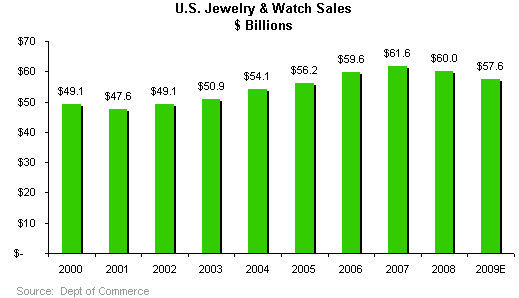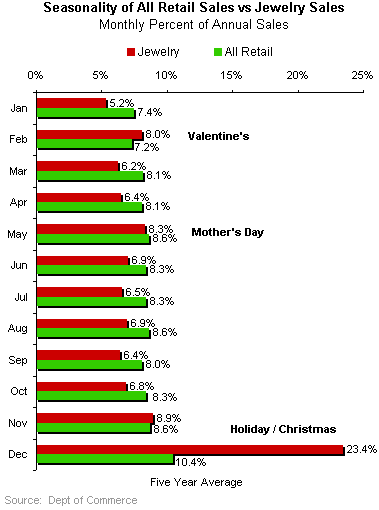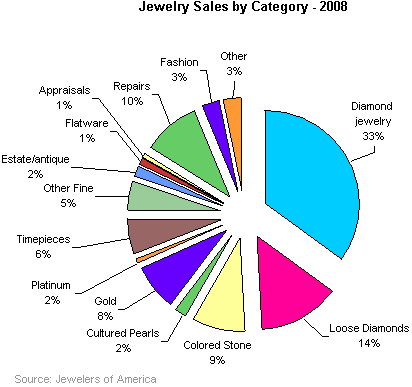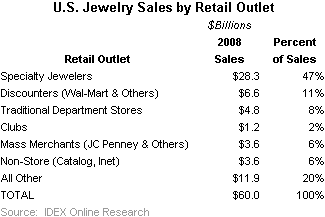IDEX Online Research: The Jewelry Industry, a Long History
October 15, 09
Jewelry is not a fad product. Archeologists have solid proof that it has been around for at least 50 millennia – and some would now argue that jewelry has been around for at least 100,000 years.
In its earliest days, people wore jewelry to denote their social and cultural identities: wealth, power and privilege. Early jewelry also provided identification of gender, age and social class. After thousands of years, these same factors continue to drive demand for jewelry. The 2008-09 recession will not derail consumers’ cultural affinity for jewelry.
The U.S. Jewelry Market
Total U.S. jewelry and watch sales were $60.0 billion in 2008, down about 2.7 percent from 2007. Jewelry sales represent about 89 percent of total industry sales, and watch sales are 11 percent of industry revenues; this sales mix has shown little change over the past decade.
In the recessionary economy of 2009, jewelry and watch sales are expected to be about $57.6 billion, down about 4 percent from 2008. Jewelry and watch sales during the November-December 2009 holiday selling season are expected to be about flat compared to the same two-month period last year.
The worldwide jewelry and watch market is estimated to be between $135 and $140 billion. The U.S. market represents just under 50 percent of the total global jewelry and watch market. By comparison, America’s Gross Domestic Product represents about 28 percent of global GDP, and the U.S. population is roughly 5 percent of the world’s total.
Following please find the when, what and where of jewelry purchases. You can also download this holiday backgrounder in PDF format.
For more information, please contact Ken Gassman at IDEX Online: +1-804-347-2395 or research@idexonline.com.

WHEN Jewelry Is Purchased
Jewelry retailing is primarily “event” driven – that is, seasonal events create spikes in consumer demand for jewelry. For example, the seasonal events of Christmas, Hanukkah and Kwanzaa create a retail sales surge for all retailers in November and December, with some impact in early January.
For jewelers, the holiday period of November and December is the most important selling season of the year. Jewelers generate just over 32 percent of their annual sales in the months of November and December (see graph below). In contrast, other retailers – discounters, department stores, and some specialty merchants, for example – generate about 19 percent of their annual sales in this all-important two-month period, as the graph below illustrates.
As the graph illustrates, months with a major sales event or holiday – Valentine’s, Mother’s Day, and Christmas / Hanukkah / Kwanzaa – generate particularly strong sales for American jewelers (red bars). Total U.S. retail sales (green bars) show much less seasonality by month.

WHAT Jewelry Is Purchased
Historically, more diamond jewelry is sold in November and December than at any other time of year; jewelers refer to strong diamond demand as their “white Christmas.” Diamond jewelry – necklaces, bracelets, rings – are particularly popular.
Further, while summer is the most popular time for weddings, nearly 20 percent of all brides become engaged in December, resulting in a surge of demand for engagement rings in the final months of the year. Mass market specialty jewelers generate up to 40 percent of their sales from bridal jewelry.

WHERE Jewelry Is Purchased
Specialty jewelers – independents and chain merchants – generate almost half of all jewelry sales in the U.S. There are just fewer than 23,000 specialty jewelers in the U.S.; they operate about 27,000 stores nationwide.
Sterling Jewelers, which operates Kay Jewelers, Jared, and several regional brands, is the largest specialty jeweler in the U.S. (based on revenues), followed closely by Zale Corporation which operates Zale’s, Zale’s Outlet, Gordon’s, Piercing Pagoda, and Peoples / Mappins (Canada). The largest retailer of jewelry in the U.S. market is Wal-Mart.
In total, there are about 128,000 outlets for jewelry, including specialty jewelers, department stores, mass market merchants, discounters, and others.
Online jewelry sales are difficult to track. Online jewelry merchants – those who sell exclusively online – represent about two-thirds of the online jewelry market, while store-based jewelers’ online sales represent about one-third of the online market. Diamonds and diamond jewelry represent about 80 percent of the jewelry sold online. An estimated 6 percent of all jewelry sales are made online, as the table below illustrates.
